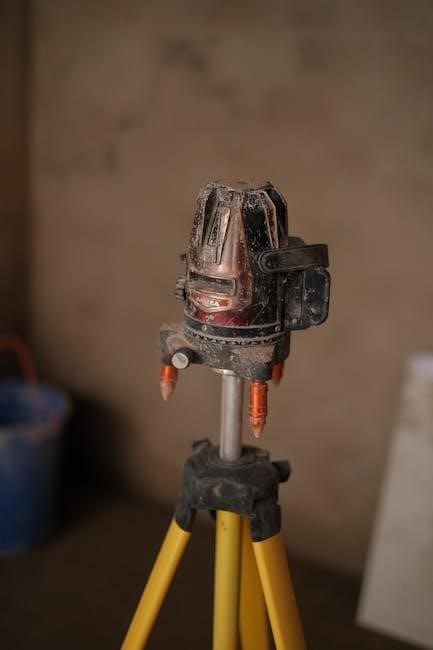Manual drum pumps are essential tools for transferring liquids from drums. They offer a reliable, portable solution for various industries, enhancing efficiency and safety in fluid handling.
1.1 Definition and Purpose
A manual drum pump is a device used to transfer liquids from drums or containers without electricity. Its purpose is to provide a safe, efficient, and controlled way to dispense fluids, eliminating risks associated with manual pouring. Ideal for various environments, these pumps reduce spillage and contamination, ensuring precise liquid transfer. They are versatile, handling oils, chemicals, and water, making them essential in industries like manufacturing, agriculture, and laboratories.
1.2 Brief History and Evolution
Manual drum pumps have evolved significantly since their inception in early industrialization. Initially, basic designs were used for transferring liquids in factories. Over time, advancements in materials and engineering led to more efficient models. Early versions were often made of metal, while modern pumps incorporate durable plastics and corrosion-resistant materials. Innovations in design, such as rotary and piston mechanisms, have enhanced performance. Today, these pumps are integral to various industries, offering reliability and versatility.

Types of Manual Drum Pumps
Manual drum pumps are available in various types, each designed for specific applications. Common types include piston-operated, rotary, squeeze action, and lever-operated models, catering to different fluid needs.
2.1 Piston-Operated Pumps
Piston-operated pumps use a piston and cylinder mechanism to transfer liquids. They are durable and ideal for thick or viscous fluids like oils and greases. These pumps offer a high flow rate and are commonly used in industrial settings. The piston’s up-and-down motion creates suction, drawing liquid into the cylinder and expelling it through the discharge spout, making them reliable for heavy-duty applications.
2.2 Rotary Hand Pumps
Rotary hand pumps are a popular choice for manual drum pumping, utilizing a hand-cranked rotary mechanism to transfer liquids. Known for their simplicity and effectiveness, these pumps are ideal for oils, fuels, and other fluids. They feature durable construction, easy operation, and low maintenance, making them suitable for industrial and agricultural settings. Their portability and versatility ensure reliable performance in various environments, enhancing fluid handling efficiency without the need for electricity.
2.3 Squeeze Action Pumps
Squeeze action pumps operate by compressing a flexible diaphragm or cylinder, creating suction to draw liquid from the drum. Their compact design and lightweight construction make them portable and easy to use. These pumps are ideal for low-viscosity fluids like water or chemicals. They offer a simple, cost-effective solution for small-scale applications, requiring minimal maintenance and providing reliable performance in various industrial and commercial settings. Their ease of use ensures quick fluid transfer with minimal effort.
2.4 Lever-Operated Pumps
Lever-operated pumps use a manual lever to create suction, drawing liquid from the drum. They are commonly used in industrial settings for transferring viscous fluids. The lever mechanism allows for efficient pumping with minimal effort. These pumps are durable, easy to operate, and suitable for heavy-duty applications. Their simple design ensures reliability and longevity, making them a popular choice for handling thick or corrosive liquids in various industrial environments.

How Manual Drum Pumps Work
Manual drum pumps operate by creating suction or pressure through mechanical movement, such as turning a handle, to draw liquid from a drum and dispense it. They are portable, reliable, and require no electricity, making them ideal for various fluid transfer tasks in different environments. Their simple design ensures efficient and safe operation, catering to diverse industrial and commercial needs.
3.1 Key Components
A manual drum pump typically consists of a pump body, piston or rotary mechanism, intake valve, discharge valve, and a handle. The pump body houses the internal components, while the piston or rotary mechanism creates suction or pressure to move the liquid. Valves regulate fluid flow, ensuring efficient transfer. The telescoping tube or suction pipe connects to the drum, allowing precise liquid extraction. These components work together seamlessly to ensure reliable operation and precise control over fluid dispensing, making manual drum pumps versatile tools for various applications;
3.2 Operating Principle
Manual drum pumps operate by creating suction or pressure through a handle. Turning or pressing the handle activates an internal piston or rotary mechanism, drawing liquid into the pump. The liquid is then expelled through a discharge valve. This process is repeated to transfer fluids effectively. The mechanism ensures controlled and efficient liquid movement, suitable for various applications.

Benefits of Using Manual Drum Pumps
Manual drum pumps are cost-effective, easy to use, and reliable. They eliminate the need for electricity, offering a portable solution for transferring liquids safely and efficiently.
4.1 Cost-Effectiveness
Manual drum pumps are a budget-friendly option for liquid transfer, requiring minimal initial investment. They eliminate electricity costs and reduce maintenance expenses, making them a financially sustainable choice for industries. Their durability ensures long-term savings, and the absence of complex components lowers repair costs. This affordability makes them accessible for small-scale operations and businesses seeking economical solutions without compromising performance or safety.
4;2 Safety and Reliability
Manual drum pumps are designed with safety and reliability in mind, ensuring secure liquid transfer. Their robust construction minimizes leakage risks, while easy operation reduces accidents. Without electrical components, they eliminate fire hazards, making them ideal for flammable environments. Durable materials and simple mechanisms provide consistent performance, reducing downtime and ensuring dependable operation across various industrial settings. This reliability makes them a trustworthy choice for critical fluid handling tasks.

Applications of Manual Drum Pumps
Manual drum pumps are widely used in industries, commercial settings, laboratories, and agriculture for transferring liquids like chemicals, fuels, and water. Their versatility and reliability make them essential for various fluid handling needs.
5.1 Industrial Use
Manual drum pumps are extensively used in industries for transferring chemicals, fuels, and oils. They are ideal for hazardous environments, ensuring safe and controlled liquid transfer. Their durability and compatibility with various liquids make them a preferred choice in chemical plants, manufacturing facilities, and oil refineries. These pumps minimize spillage and reduce manual labor, enhancing efficiency and safety in industrial operations. They are also cost-effective solutions for small to medium-scale liquid handling needs in industrial settings.
5.2 Commercial Use
Manual drum pumps are widely utilized in commercial settings for handling various fluids efficiently. They are commonly found in service stations, workshops, and storage facilities. Their portability and ease of use make them ideal for transferring oils, lubricants, and other liquids. In commercial environments, these pumps reduce labor costs and ensure safe fluid management. They are also preferred for their reliability and low maintenance, making them a practical solution for daily operations in commercial spaces.
5.3 Laboratory Use
Manual drum pumps are frequently used in laboratory settings for precise handling of chemicals and fluids. Their compact design and manual operation make them ideal for small-scale transfers, ensuring accuracy and minimizing waste. Laboratories rely on these pumps for safe dispensing of sensitive materials, as they eliminate the risk of electrical hazards. Easy to clean and maintain, manual drum pumps support laboratory tasks requiring careful fluid management and contamination control.
5.4 Agricultural Use
Manual drum pumps are widely utilized in agricultural settings for transferring fertilizers, pesticides, and water. Their portability and ease of use make them ideal for remote farming operations. Farmers often rely on these pumps for dispensing liquids in controlled amounts, reducing waste and ensuring efficient resource management. They are also used for refueling equipment and handling chemicals safely, supporting sustainable farming practices and maintaining environmental safety in rural areas.

Choosing the Right Manual Drum Pump
Selecting the appropriate manual drum pump involves considering factors like flow rate, material compatibility, and intended use. Ensure the pump matches your specific fluid and application needs for optimal performance.
6.1 Factors to Consider
When selecting a manual drum pump, consider flow rate, viscosity, and compatibility with the liquid. Also, check the pump’s durability, ease of operation, and suitability for the drum size. Ensure it meets safety standards and environmental regulations. Consider maintenance requirements and warranty. Portability and ergonomics are crucial for efficient use. Compatibility with accessories like hoses and nozzles is also important. Assess user reviews for reliability and performance.
6.2 Material Compatibility
Material compatibility is crucial for manual drum pumps. Ensure the pump’s materials, such as stainless steel, polypropylene, or Viton, are resistant to the liquid being transferred. Corrosion-resistant materials are essential for harsh chemicals. Food-grade materials are necessary for edible liquids. Always check compatibility charts to avoid damage or contamination. Proper material selection ensures safety, efficiency, and longevity of the pump, making it suitable for diverse industrial and commercial applications. Prioritize durability and chemical resistance for optimal performance.

Maintenance and Care
Regular maintenance ensures optimal performance and longevity of manual drum pumps. Clean components, inspect for wear, and replace seals as needed to prevent leaks and maintain efficiency.
7.1 Routine Maintenance
Regular maintenance is crucial for extending the life of manual drum pumps. Clean the pump and drum connections thoroughly after each use to prevent contamination. Inspect seals and gaskets for wear and replace them promptly to avoid leaks. Lubricate moving parts periodically to ensure smooth operation. Store the pump in a dry, clean environment when not in use to prevent rust and damage. Proper care ensures consistent performance and reliability over time.
7.2 Storage Tips
Store manual drum pumps in a dry, clean environment to prevent rust and contamination. Ensure the pump is completely drained of liquid before storage. Use protective covers or packaging to shield against dust and physical damage. Keep the pump upright to avoid leakage and maintain its integrity. Regularly inspect stored pumps for signs of wear or damage. Proper storage extends the pump’s lifespan and ensures readiness for future use.
Safety Tips for Using Manual Drum Pumps
Always use compatible pumps for the liquid type, check for leaks, ensure the area is well-ventilated, wear protective gear, and avoid overfilling the drum.
8.1 Pre-Operation Checks
Before using a manual drum pump, inspect for leaks, ensure compatibility with the liquid, check the drum’s condition, and verify all connections are secure. Wear protective gear, including gloves and goggles, and ensure the area is well-ventilated. Proper preparation prevents accidents and ensures smooth, efficient operation. Always consult the manufacturer’s guidelines for specific pre-use checks tailored to your pump model and application.
8.2 Handling and Environment
Ensure the drum is stable and securely positioned during transport and operation. Use manual drum pumps on level, firm surfaces to prevent tipping. Avoid extreme temperatures and corrosive environments to maintain pump durability; Always secure the drum lid tightly after use and store the pump in a clean, dry place. Proper handling and environmental care extend the pump’s lifespan and ensure safe, efficient operation.
Advantages Over Electric Pumps
Manual drum pumps are cost-effective, lightweight, and energy-efficient, requiring no electricity, making them ideal for remote or power-limited locations while reducing operational costs and environmental impact.
9.1 Portability
Manual drum pumps are lightweight and compact, making them easy to transport and use in various locations. Their portability is a significant advantage, especially in remote or outdoor settings where electricity is unavailable. This feature allows users to move the pump between drums or sites without additional equipment, enhancing flexibility and efficiency in fluid transfer tasks across industries.
9.2 No Power Dependency
Manual drum pumps operate without electricity, eliminating reliance on power sources. This independence is crucial in areas with frequent outages or where access to electricity is limited. Their mechanical design ensures consistent performance, making them a dependable choice for transferring fluids in off-grid or emergency situations, thus providing unparalleled convenience and reliability compared to electric alternatives.

Troubleshooting Common Issues
Manual drum pumps can experience issues like low flow or leakage. Regular maintenance and inspection help identify and resolve these problems efficiently, ensuring optimal performance.
10.1 Low Flow Rate
A low flow rate in manual drum pumps can be caused by clogged valves or worn-out seals. Ensuring all parts are clean and replacing damaged components typically resolves the issue. Regular lubrication of moving parts also helps maintain optimal performance. Always check for blockages in the pump or discharge hose, as these can significantly reduce flow efficiency. Proper maintenance is key to preventing such problems.
10.2 Leakage Problems
Leakage in manual drum pumps often occurs due to worn-out seals or gaskets. Inspect the pump’s connections and replace any damaged parts. Tightening loose fittings can also resolve minor leaks. Ensure all components are properly aligned and lubricated. Regular maintenance, including checking for wear and tear, helps prevent leakage issues. Addressing leaks promptly is crucial to avoid fluid spills and maintain operational efficiency.

Environmental Impact
Manual drum pumps contribute positively by preventing spills and reducing waste. They often use eco-friendly materials and energy-efficient designs, minimizing the environmental footprint and promoting sustainable practices.
11.1 Eco-Friendly Aspects
Manual drum pumps are eco-friendly, as they operate without electricity, reducing carbon emissions. They minimize liquid spills, preventing environmental contamination. Made from durable, long-lasting materials, they reduce waste and the need for frequent replacements. Many models are recyclable, further lowering their environmental impact. Their sustainable design aligns with green practices, making them a responsible choice for liquid handling needs while promoting environmental conservation and reducing ecological footprints.
11.2 Waste Management
Manual drum pumps play a crucial role in waste management by enabling precise control over liquid transfer, reducing spills and contamination. They help in emptying drums completely, minimizing residual waste. Durable construction reduces frequent replacements, lowering disposal needs. Their manual operation avoids electronic waste, supporting sustainable practices. By preventing overflows and ensuring efficient transfer, these pumps contribute to cleaner environments and eco-friendly waste management in industrial and commercial settings.

Future Trends in Manual Drum Pumps
Future trends include advanced materials, ergonomic designs, and integration of smart technologies for enhanced efficiency and user experience, driving innovation in fluid handling solutions globally.
12.1 Technological Innovations
Technological advancements are transforming manual drum pumps with smart sensors, adjustable flow controls, and lightweight materials. These innovations enhance efficiency, reduce user fatigue, and improve precision, making them indispensable in modern industries. Integration of IoT for real-time monitoring and maintenance scheduling is also on the rise, ensuring optimal performance and safety.
12.2 Industry Adaptations
Industries are adapting manual drum pumps to meet specific needs, with designs tailored for chemicals, food processing, and hazardous environments. Customizable options, such as adjustable flow rates and modular designs, enhance versatility. These adaptations ensure pumps align with industry standards, improving efficiency and safety for diverse applications, from agriculture to laboratories.
Manual drum pumps are versatile, cost-effective solutions for fluid transfer, offering reliability and safety across industries. Their adaptability to various environments and substances makes them indispensable tools. As industries evolve, so too will these pumps, ensuring continued relevance and efficiency in meeting diverse needs.
